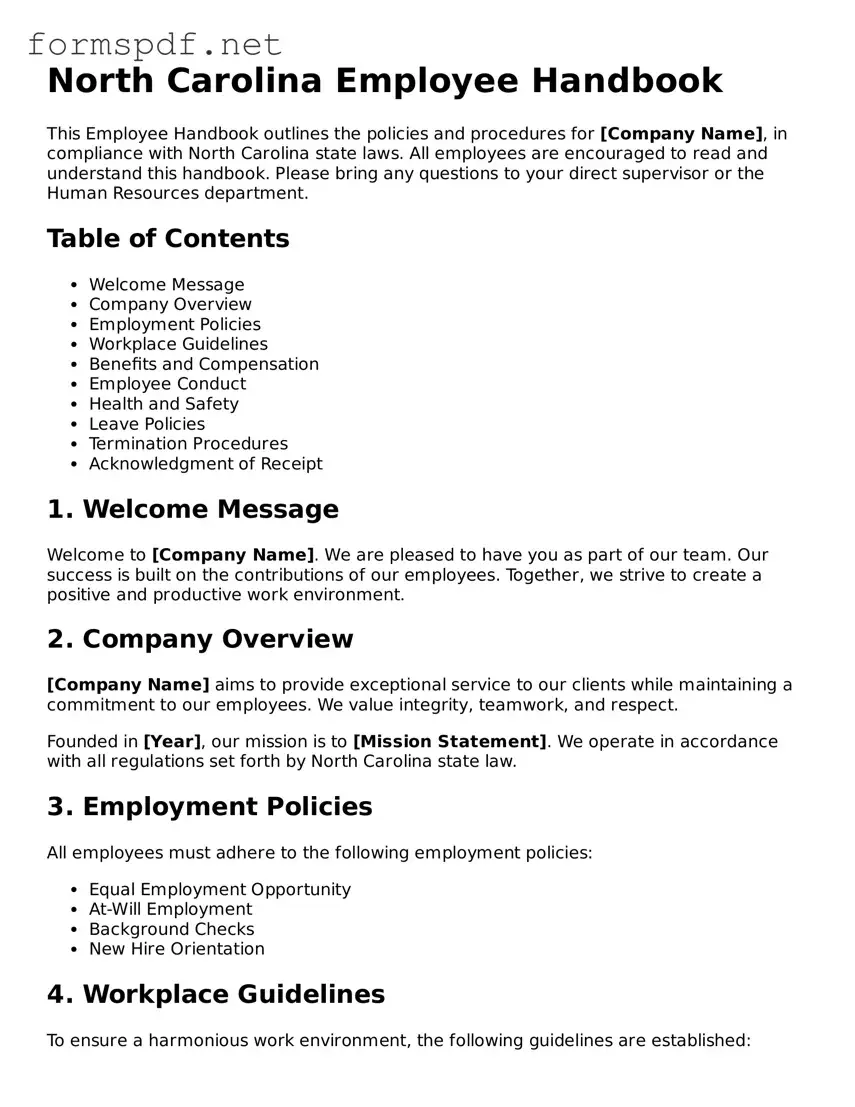North Carolina Employee Handbook
This Employee Handbook outlines the policies and procedures for [Company Name], in compliance with North Carolina state laws. All employees are encouraged to read and understand this handbook. Please bring any questions to your direct supervisor or the Human Resources department.
Table of Contents
- Welcome Message
- Company Overview
- Employment Policies
- Workplace Guidelines
- Benefits and Compensation
- Employee Conduct
- Health and Safety
- Leave Policies
- Termination Procedures
- Acknowledgment of Receipt
1. Welcome Message
Welcome to [Company Name]. We are pleased to have you as part of our team. Our success is built on the contributions of our employees. Together, we strive to create a positive and productive work environment.
2. Company Overview
[Company Name] aims to provide exceptional service to our clients while maintaining a commitment to our employees. We value integrity, teamwork, and respect.
Founded in [Year], our mission is to [Mission Statement]. We operate in accordance with all regulations set forth by North Carolina state law.
3. Employment Policies
All employees must adhere to the following employment policies:
- Equal Employment Opportunity
- At-Will Employment
- Background Checks
- New Hire Orientation
4. Workplace Guidelines
To ensure a harmonious work environment, the following guidelines are established:
- Punctuality and Attendance
- Dress Code
- Use of Company Property
- Work Performance Expectations
5. Benefits and Compensation
Our compensation packages include:
- Competitive Salaries
- Health Insurance
- Retirement Plans
- Paid Time Off
6. Employee Conduct
Employees must reflect our company values in their conduct. Expectations include:
- Respectful Communication
- Harassment-Free Workplace
- Confidentiality
- Compliance with Regulations
7. Health and Safety
Employee safety is a priority. Adhere to all safety procedures to maintain a safe work environment.
- Emergency Protocols
- Workplace Hazards
- Accident Reporting
8. Leave Policies
Employees are entitled to various types of leave. These include:
- Paid Sick Leave
- Vacation Leave
- Family and Medical Leave (FMLA)
- Holidays
9. Termination Procedures
Termination of employment may occur for various reasons. Employees are encouraged to familiarize themselves with the termination process, including:
- Voluntary Resignation
- Involuntary Termination
- Exit Interviews
10. Acknowledgment of Receipt
All employees must sign the acknowledgment form confirming that they have received and understood this Employee Handbook. The signed form should be submitted to [HR Contact Name].
